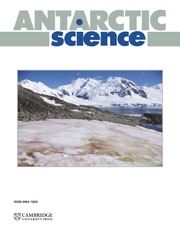Introduction
In 2032–2033, the world will celebrate the fifth International Polar Year (Scientific Committee for Antarctic Research 2024).Footnote 1 Delivered through a collaboration between the Antarctic and Arctic sectors, International Polar Years (or IPYs) offer an opportunity to build workforce capacity and strengthen public understanding of and engagement with the north and south polar regions (Salmon et al. Reference Salmon, Carlson, Zicus, Pauls, Baeseman and Sparrow2011, Carlson Reference Carlson2019, Salmon & Priestley Reference Salmon and Priestley2019, Salmon & Roop Reference Salmon and Roop2019, Xavier et al. Reference Xavier, Mateev, Capper, Wilmotte and Walton2019). The most recent IPY, conducted in 2007–2008, delivered a range of outcomes relating to public engagement, including the establishment of Polar Educators International (Salmon & Roop Reference Salmon and Roop2019, Xavier et al. Reference Xavier, Mateev, Capper, Wilmotte and Walton2019) and the stimulation of a ‘fresh wave of excitement, energy, commitment and interest in what was coined Education, Outreach and Communication, or EOC’ (Salmon & Priestley Reference Salmon and Priestley2019). As described by Salmon et al. (Reference Salmon, Carlson, Zicus, Pauls, Baeseman and Sparrow2011), the groups overseeing the 2007–2008 IPY planned their engagement strategy through an in-depth design process that included extensive collaboration and stakeholder consultation, both being factors that might have contributed to the IPY’s success in this area.
For those in the Antarctic sector, the 2032–2033 IPY will take place in a somewhat different political and environmental climate from its predecessor. The recent loss of sea ice has demonstrated the impact that climate change is having on Antarctica (Purich & Doddridge Reference Purich and Doddridge2023), as the region also faces challenges relating to plastics pollution (De-la-Torre et al. Reference De-la-Torre, Santillán, Dioses-Salinas, Yenney, Toapanta and Okoffo2024) and increasing geopolitical tension (Buchanan Reference Buchanan2023). Within this context, it is more important than ever to ensure that the Antarctic sector is ready to capitalize on opportunities such as the 2032–2033 IPY so that members of the public can be knowledgeable and passionate about Antarctica, its environmental systems and its governance.
Increasingly, the Antarctic sector is recognizing the importance of public engagement. The Scientific Committee on Antarctic Research (SCAR) and the Council of Managers of National Antarctic Programs (COMNAP) both have groups dedicated to engagement, and the Antarctic Treaty Consultative Parties established an Intersessional Contact Group on Education and Outreach in 2015 (Secretariat of the Antarctic Treaty 2015, Xavier et al. Reference Xavier, Mateev, Capper, Wilmotte and Walton2019, Reference Xavier, Mateev, Wilmotte, Peña-Aguirre, Jupe and Ramos-García2024). As Salmon & Roop (Reference Salmon and Roop2019) point out, however, the sector’s efforts towards public engagement are often stymied by a lack of strategy. Current engagement-focused research tends to concentrate on various publics, examining their level of Antarctic knowledge and how they think and feel about Antarctica (Hamilton et al. Reference Hamilton2008, Reference Hamilton, Cutler and Schaefer2012, del Acebo Ibáñez & Costa Reference del Acebo Ibáñez and Costa2010, Colmar Brunton 2011, 2015, Neufeld et al. Reference Neufeld, O'Reilly, Summerson, Tin, Tin, Liggett, Maher and Lamers2013, Salazar Reference Salazar, Liggett and Hemmings2013, Ahmad Shabudin et al. Reference Ahmad Shabudin, Abdul Rahim, Md Nor and Ibrahim2016 , Peden et al. Reference Peden, Tin, Pertierra, Tejedo and Benayas2016, Tin et al. Reference Tin, O'Reilly, Peden, Pinkalla, Kelly and Larrea2018, Reference Tin, Peden, O'Reilly, Bastmeijer and Maher2019, Goh et al. Reference Goh, Wahab, Alias, Yusof and Komaruddin2019, Leane et al. Reference Leane, Lucas, Marx, Datta, Nielsen and Salazar2021, Chung et al. Reference Chung, Choi, Kim and Shin2022, Pallahuala et al. Reference Pallahuala, Igor, Gómez, Caidane, Díaz Muñoz and Estrada-Goic2022, Estrada-Goic et al. Reference Estrada-Goic, González-Ortega, Mancilla, Latorre, Cerda and Jalil2023, Tranter & Leane Reference Tranter and Leane2023). In this paper, we argue that in order to understand and strengthen public engagement with Antarctica it is necessary to turn our gaze on those who are doing the engaging. Through an exploratory survey that builds on earlier studies (e.g. Salmon & Roop Reference Salmon and Roop2019), we have aimed to create a snapshot of the Antarctic sector’s current capacity to conduct public engagement.
Current understanding of public engagement capacity in the Antarctic and related sectors
For the purposes of this study, we have drawn upon the work of Rowe & Frewer (Reference Rowe and Frewer2005) to define ‘Antarctic public engagement’ as a broad term that may include the following:
-
1) Public communication: informing the public about Antarctic research
-
2) Public consultation: asking the public about what they think and feel about Antarctic research
-
3) Public participation: exchanging ideas and thoughts with the public about Antarctic research and working together on research activities
Various other terms are used more or less synonymously with ‘public engagement’. ‘Education, outreach and communication’ (EOC) as a term has been used previously within the Antarctic social sciences and humanities (Salmon & Roop Reference Salmon and Roop2019). The naming of COMNAP’s Education, Outreach and Training group and the Antarctic Treaty Consultative Parties’ Intersessional Contact Group on Education and Outreach indicates that similar terminology is prevalent within Antarctic governance. While we prefer ‘public engagement’ here, in line with broader academic practice (e.g. Rowe & Frewer Reference Rowe and Frewer2005), our synthesis to follow draws on relevant research under any of these related terms.
Antarctic sector engagement capacity
The nearly 60 nations that are signatories to the Antarctic Treaty have a mandate for public engagement. While the Antarctic Treaty itself is silent on the topic, the Protocol on Environmental Protection to the Antarctic Treaty alludes to it (Xavier et al. Reference Xavier, Mateev, Capper, Wilmotte and Walton2019), and an increasing number of Information Papers submitted to Treaty Meetings emphasize its importance (Xavier et al. Reference Xavier, Mateev, Wilmotte, Peña-Aguirre, Jupe and Ramos-García2024).
Despite this mandate, very little research has focused on what factors are needed for public engagement to be met. Almost no scholarship has looked at the people and processes involved in Antarctic sector engagement - the exception being a cluster of articles published in a 2019 special issue of Polar Record reflecting on engagement efforts during the fourth IPY a decade earlier. While these articles, like the IPY, deal with both polar regions, because the IPY is a scientific effort, the Antarctic is a key focus.
Reflecting on a decade of polar public engagement with a focus on Antarctic case studies, Salmon & Roop (Reference Salmon and Roop2019) identify a series of factors that created a ‘lack of professionalism’ in this activity. A key problem is insufficient attention to the evaluation of engagement projects due to a lack of funding, expertise or reporting requirement. Related to this is an undervaluing of the engagement skillset in terms of time, effort and expertise and a subsequent outsourcing of the activity to volunteers and graduate students - something that reinforces the lack of professionalism they observe. Other obstacles include: a lack of clear strategic objectives; an environment in which only ‘good news’ stories are acceptable; and a gap between those producing current theory of best-practice engagement (largely social scientists) and those doing the engagement (largely natural scientists).
Other publications echo and expand these observations. Carlson (Reference Carlson2019), focusing on engagement related to both polar regions in and since the last IPY, notes the unsustainability of efforts that rely on volunteers and the inevitable drop-off of communication and collaboration between people and groups working in the engagement space after the IPY excitement has passed. Salmon & Priestley (Reference Salmon and Priestley2019) also mention this sustainability problem. They also suggest reasons for the lack of evaluative or analytical components to IPY ‘EOC’ efforts: the absence of any research framework in the initial establishment of these efforts; and the fact that practitioners - predominantly natural scientists - had no incentives to publish any engagement-related data they might have collected due to the tangential nature of this information to their core disciplines. These observations provide possible lessons for the future, including the upcoming fifth IPY.
Much more research exists on public engagement (broadly conceived) focusing on regions or issues adjacent to the Antarctic. Arctic-specific (as opposed to polar) research on engagement might seem to provide a useful comparator, but the distinctiveness of the two regions - particularly the long-inhabited and settled nature of the Arctic - means that most of this work has very limited Antarctic relevance. Much Arctic engagement research focuses on communities, both Indigenous and settler (e.g. Henri et al. Reference Henri, Brunet, Dort, Odame, Shirley and Gilchrist2020, Mathisen & Morlandsto Reference Mathisen and Morlandstø2022), and so is not particularly applicable to the Antarctic context. Work that deals with remote audiences tends to focus on media framing of Arctic issues (Pincus & Ali Reference Pincus and Ali2016, Christensen & Nilsson Reference Christensen and Nilsson2017) or on what polar, near-polar and low-latitude communities know and think (e.g. Hamilton Reference Hamilton, Cutler and Schaefer2012, Pakszys et al. Reference Pakszys, Zieliński, Ferrero, Kotyńska-Zielińska and Wichorowski2020). The engagement sector itself is rarely discussed, and indeed in the Arctic region, which includes multiple sovereign nations and Indigenous peoples, the idea of a coherent sector makes far less sense than in the internationally governed and science-focused Antarctic. Arctic-related research tends to become relevant primarily in the context of scientific endeavours such as the IPY.
Climate change communication research, which relates strongly to both polar regions, has unsurprisingly proliferated in recent years, with there having been several thousand publications over the quarter of a century to 2020 (Canon et al. Reference Canon, Boyle and Hepworth2022). However, this literature largely focuses on public perceptions or the various techniques communicators use (Canon et al. Reference Canon, Boyle and Hepworth2022) rather than sector capacity. Moreover, the challenges faced by public engagement practitioners focused on the Antarctic region are distinct from those of climate change communicators, not least because climate change - although in one sense a hyperobject too large and dispersed to see or grasp (Morton Reference Morton2013) - is also immediately present in terms of changing weather patterns and extreme events, while Antarctica remains visible to the vast majority of people only indirectly, through others’ stories, images and sound.
Perhaps the best analogy with the Antarctic in terms of public engagement - as in many other respects - is outer space. Both have been the focus of national scientific expeditions since the 1950s and have been, for much of the subsequent period, largely off-limits to other forms of visitation, although tourism is now an increasingly prominent activity (particularly in the Antarctic). Both are present in the public imagination primarily through the reports and artefacts of others. The space sector, and in particular the US space sector, has a strong perceived mandate for public engagement (Billings Reference Billings and Kaminski2021, Young & Reed Reference Young, Reed and Kaminski2021). This perceived mandate is partially informed by concerns around government transparency and funding, but also out of a desire to further public interest in and knowledge of science, technology, engineering and mathematics (STEM) subjects (Klug Boonstra & Boonstra Reference Klug Boonstra, Boonstra and Kaminski2021). As a result, the space sector positions itself at the forefront of public engagement with regards to science and remote environments (Stengler Reference Stengler and Kaminski2021), with a history of targeted engagement programmes dating back to the space race of the 1950s and 1960s (Young & Reed Reference Young, Reed and Kaminski2021).
In many ways, the space sector’s engagement capacity differs markedly from its Antarctic equivalent. Unlike the Antarctic programmes, with their piecemeal approach, space programmes have dedicated strategies that have helped them to understand and deliver on their engagement outcomes (Viotti Reference Viotti and Kaminski2021). This success is at least partly due to the space sector’s access to sufficient resources to conduct engagement work - particularly in the USA through NASA/the Jet Propulsion Laboratory (JPL; Viotti Reference Viotti and Kaminski2021, Young & Reed Reference Young, Reed and Kaminski2021). Levay (Reference Levay and Kaminski2021) describes NASA’s publicity resources as ‘formidable’. There are, however, some exceptions to this strong investment in engagement. Billings (Reference Billings and Kaminski2021) notes that NASA’s resourcing does not extend to the humanities and social sciences (HASS), and that interdisciplinary programmes (with well-documented engagement outcomes) do not receive long-term funding. Similarly, smaller space programmes such as the Estonian ESTCube project (Olesk & Noorma Reference Olesk, Noorma and Kaminski2021) have access to considerably fewer resources and have needed to employ different strategies to share their work with the public. Non-governmental organizations (NGOs) such as The Planetary Society have also conducted successful crowdfunding campaigns (Vaughn & Friedman Reference Vaughn, Friedman and Kaminski2021).
In other respects, the space sector has similarities to the Antarctic sector in regard to public engagement. The space sector has drawn extensively on volunteers, both to conduct engagement work (Buxner et al. Reference Buxner, Fitzgerald, Freed and Kaminski2021, Viotti Reference Viotti and Kaminski2021) and also as a way of engaging the public (i.e. through citizen science programmes; Fortner 2021, Klug Boonstra & Boonstra Reference Klug Boonstra, Boonstra and Kaminski2021, Young & Reed Reference Young, Reed and Kaminski2021). As with Antarctica, human engagement with space has in many ways been driven by the arts (Miller Reference Miller and Kaminski2021), but engagement programmes are currently very much framed through a STEM lens (Klug Boonstra & Boonstra Reference Klug Boonstra, Boonstra and Kaminski2021). The space sector has had to tackle a number of internal cultural barriers in order to successfully engage the public, including an unwillingness to share data and the perception of elitism (Viotti Reference Viotti and Kaminski2021) - a situation akin to the Antarctic, in which a legacy of heroic individualism has influenced public representation (Nielsen & Jaksic Reference Nielsen and Jaksic2018, Nielsen Reference Nielsen2023).
Several lessons from the space sector identified by researchers may have relevance to the Antarctic sector. The space sector has benefitted from having access to locations dedicated to engagement, both in the built environment (Stengler Reference Stengler and Kaminski2021) and online (Miller Reference Miller and Kaminski2021). Technological innovations that support the public to visualize space are also important (Lavey Reference Levay and Kaminski2021). One challenge is developing the space sector’s capacity to conceptualize and support robust forms of engagement, with Billings (Reference Billings and Kaminski2021) noting that the sector’s much-vaunted engagement efforts do not stretch to input from citizens beyond the science community on future plans, goals and objectives.
The pilot study that we present in the following should be contextualized both within the lack of research evident in Antarctic engagement efforts and within the possibility of a more strategic, evidence-based approach that is characteristic of related examples, particularly the space sector.
Methodology
Given that the aim of this study was to gain a snapshot of the Antarctic sector’s current capacity to conduct public engagement, it was decided that a survey approach - commonly used in the social sciences to measure attitudes and behaviours - was appropriate (Blair et al. Reference Blair, Czaja and Blair2013). Four main methods of surveying exist. Face-to-face surveys collect data directly from respondents in a specific location; they are good for high response rates but are expensive and labour-intensive. In telephone surveys, phone numbers are randomly selected from a directory; again, these have high response rates, but technologies such as caller ID can make them more difficult. Mail surveys involve sending a questionnaire instrument to an address, but they can increase response bias (where those who are not interested in the subject do not respond) and such questionnaires need to be completely self-explanatory. Finally, web-based surveys are completed online; these are low-cost, and they allow data to be collected at speed - however, they share similar disadvantages to mail surveys. Given our focus on a specific population (the Antarctic sector) with a clear online presence and the need for a low-cost survey method in our pilot study, we decided to use a web-based survey approach.
Research questions
Drawing both on the IPY lessons outlined earlier and our own experiences as social scientists working within the Antarctic research sector, we articulated two research questions (RQs) that we believe will support an understanding of the Antarctic sector’s current capacity when it comes to public engagement:
-
• RQ1: What kind of engagement work is the Antarctic sector conducting?
-
• RQ2: What are the barriers to and enablers of conducting engagement work within the Antarctic sector?
Survey instrument design
To design this survey, we consulted with the membership of the Action Group on Public Engagement with Antarctic Research (PEAR) that sits within the Scientific Committee for Antarctic Research (SCAR). PEAR exists to foster the academic study of public engagement with Antarctica, and at the time of writing it has over 100 members, all of whom have professional links to the Antarctic sector and an interest in public engagement. We designed an initial survey based on our stated RQs and informed by the issues that had been identified in the literature related to the fourth IPY as well as wider public engagement scholarship. We then hosted a Zoom workshop with interested PEAR members to review and refine the survey instrument. Attendees were divided into three groups and asked to examine the draft survey and provide feedback. Based on their experience within the Antarctic sector, workshop participants stated that it was important to include a line of enquiry around funding and to use open-ended questions to allow for a diversity of responses in regard to topics such as participants’ language and academic background. Workshop participants were also interested in including questions around the impacts and outcomes of engagement activities. It was decided, however, that this would be beyond the scope of the current research, given that the study’s focus was on sector capacity.
The final version of the survey (Table I) (Appendix 1 in Supplementary Material) had 24 questions that comprised closed and open-ended formats. These included questions on the type and frequency of the participants’ engagement activities, with the survey being designed to allow the skipping of questions should participants or their organizations not have any involvement in a given aspect of public engagement.
Table I. Summary of the survey questions that have been included in this paper.
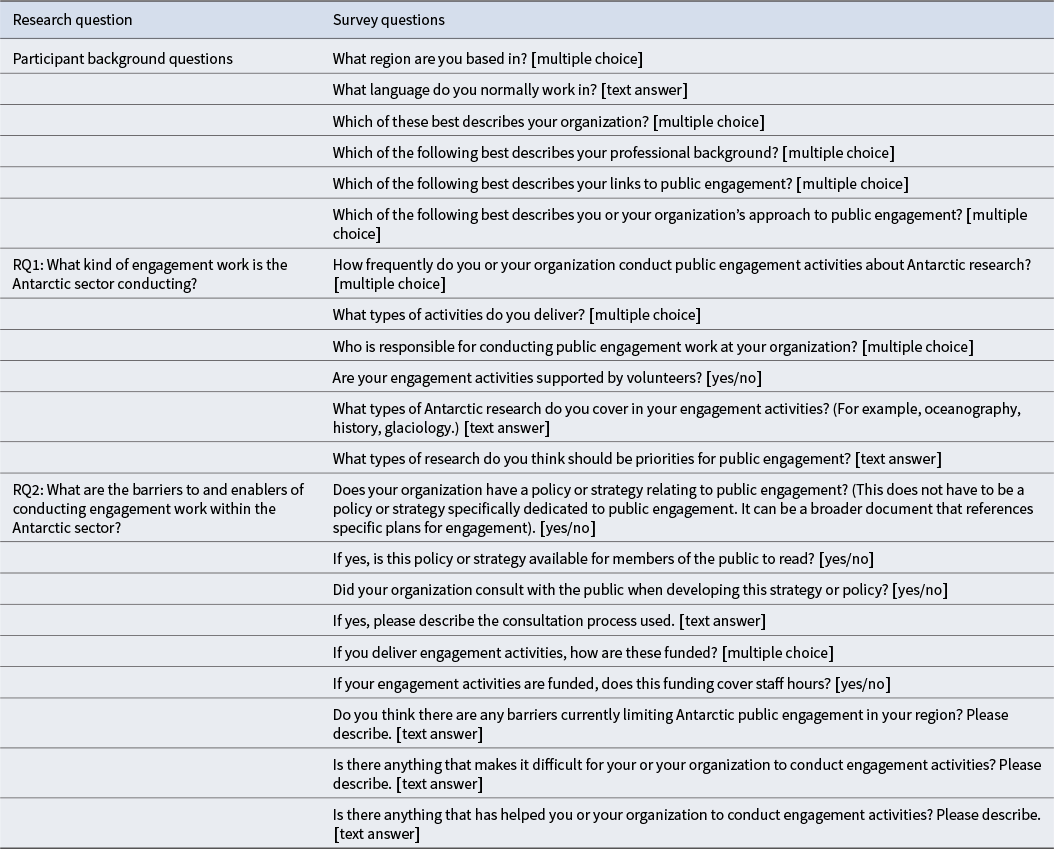
RQ = research question.
Data collection
The participants of this study (population to be sampled) operated within the global Antarctic sector, with the survey explicitly targeted towards ‘anyone from the Antarctic and Southern Ocean sector who is involved in public engagement’. Organizations of relevance included national Antarctic programmes, research institutions, tourism operators, polar educators and museums. There are currently 29 Consultative Parties to the Antarctic Treaty (Secretariat of the Antarctic Treaty 2024a), each of which have an active research programme. In addition, there are 56 tour operators currently listed within the International Association of Antarctica Tour Operators (IAATO) member directory (IAATO 2024b), over 80 museums listed within the Polar Museums Network’s directory that may contain Antarctic material (SPRI 2024) and an extensive though fluctuating number of research institutions conducting Antarctic work. The shape of this community is not easily defined, and the extent to which each of these organizations is engaging with the public is currently unknown. The overall size of the sampled population is, therefore, difficult to determine. We adopted a mixture of purposive (those organizations as detailed earlier) and snowball (research participants asked to assist in identifying other potential subjects) sampling for this project. In particular, we focused on contacting organizations that acted as peak bodies for the parts of the Antarctic sector that play a key role in public engagement, including SCAR, COMNAP, IAATO and the Polar Museums Network.
Data were collected online using the Qualtrics platform (Qualtrics, Provo, UT, USA).Footnote 2 Organizations identified as part of the purposive sampling were contacted by email, provided with an information sheet (Appendix 2 in Supplementary Material) and a link to the online survey and asked to promote the survey within their networks. The data were collected between December 2022 and February 2023. The information provided and the online survey were conducted in English. Data were exported from Qualtrics as a CSV file and stored in a password-protected shared folder. No responses contained identifying information, hence there was no need to anonymize the dataset. This project received ethics approval from the University of Tasmania Human Research Ethics Committee (28128).
There were a number of limitations to our approach to data collection. First, as all information and the survey questions were only undertaken in English, this will have led to a linguistic bias and potentially excluded respondents from, for example, French, Spanish, Russian (the official languages of the Antarctic Treaty in addition to English) as well as Chinese organizations. Second, there was a large reliance on Antarctic peak bodies due to limitations in resources (time and cost) to undertake the study.
Data analysis
As the survey combined closed and open-ended questions, two forms of data analysis were undertaken: 1) a quantitative descriptive statistical analysis of closed questions and 2) a qualitative thematic analysis of open-ended questions. Descriptive statistics are often used in new areas of enquiry (as this study was) and represent a descriptive understanding of the sample being studied (Vetter Reference Vetter2017). Such statistics commonly include frequency, percentage, ratio and proportion. Thematic analysis is a method that is used to identify, analyse and report patterns within data (Braun & Clarke Reference Braun and Clarke2006). In this study, an inductive approach to thematic coding was undertaken, meaning that the themes identified were strongly linked to the data themselves, and no pre-existing coding framework was used. Data were imported into QSR International’s NVivo14 software - a computer-assisted qualitative data analysis software that facilitates coding and retrieval. Two researchers worked together to undertake coding using a spilt and consensus coding approach to ensure that the codebook was not biased by the perspectives of a single coder.
Results
Eighty-eight people responded to the survey. Twelve of these responses were not completed, leaving a final sample of 76 participants. While we achieved representation from each continent, the majority of participants came from Oceania (n = 18) and Europe (n = 18). The vast majority of participants (n = 59) identified as English speakers, with a small number speaking Portuguese, Spanish, Polish, Czech, German and Hindi. This is consistent with the fact that the survey was delivered only in English. We aim to broaden representation by offering future iterations of the survey in other languages. Forty-eight participants came from universities or other research institutions, with the remaining participants coming from NGOs (n = 7), national Antarctic programmes (n = 5), tourism operators (n = 3), governmental organizations not including Antarctic programmes (n = 1), intergovernmental organizations (n = 1), museums or visitor centres (n = 1), education-focused organizations (n = 1) or something else (n = 3). A further five participants identified as independent operators. Consequently, the findings from this survey are strongly skewed towards universities and research institutions and are not necessarily representative of the broader Antarctic sector. Again, this is consistent with the difficulties we encountered in our recruitment phase, and in future surveys we hope to elicit more responses from outside of academia. It should be noted, however, that engagement professionals often work across multiple contracts with multiple institutions.
From a disciplinary perspective, the majority of participants came from a STEM background (n = 24) or from the HASS (n = 21; Fig. 1). Based on the authors’ own lived experience and the composition of SCAR (three natural science groups, one HASS equivalent), the HASS are currently within the minority of the Antarctic sector’s disciplinary makeup. The relatively high level of HASS representation within this participant sample is at least partially attributable to the authors’ own backgrounds and networks as well as the fact that this survey has originated from within a HASS action group and deals with a topic - public engagement - usually studied from a HASS perspective.
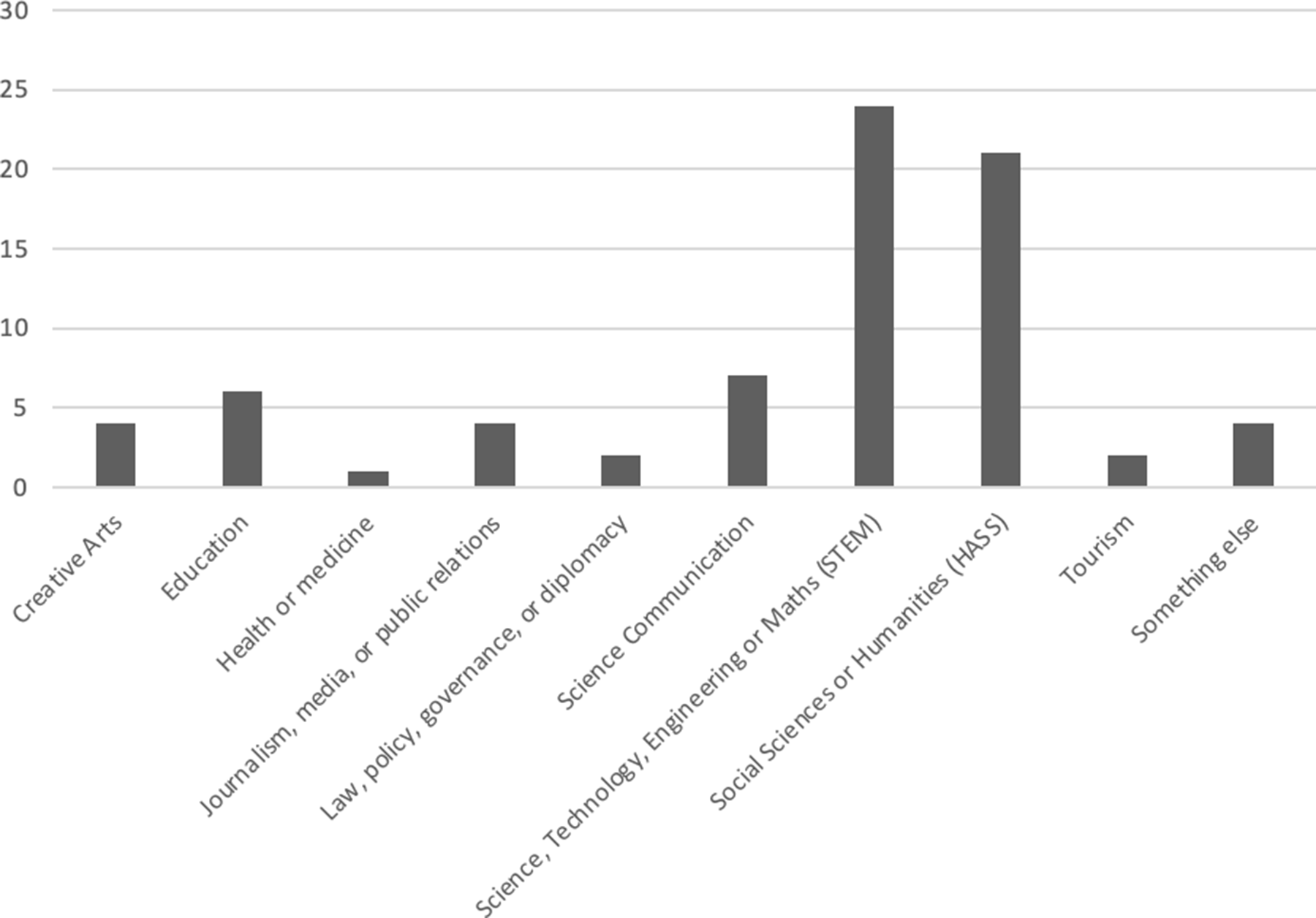
Figure 1. Responses to the question ‘Which of the following best describes your professional background?’.
While the survey was aimed at participants involved in Antarctic sector public engagement, respondents varied in terms of the relationship that they and their organizations had to this activity. The largest group (35%; n = 27) were directly responsible for delivering public engagement activities; 23% (n = 18) were part of organizations that deliver engagement activities but were not directly responsible themselves; and the remainder conducted research about engagement (n = 8), had an interest but no involvement in engagement (n = 10), had no interest or involvement in engagement (n = 3) or something else (n = 9). While a small number of participants (n = 5) reported that engagement work was their organization’s core business, for the majority of respondents it was not (Fig. 2). For most participants, engagement work was: important but not core to their business (n = 25); something that they did when the opportunity arose (n = 14); something that was part of what they did but not an important part (n = 7); or not part of their work at all (n = 1).
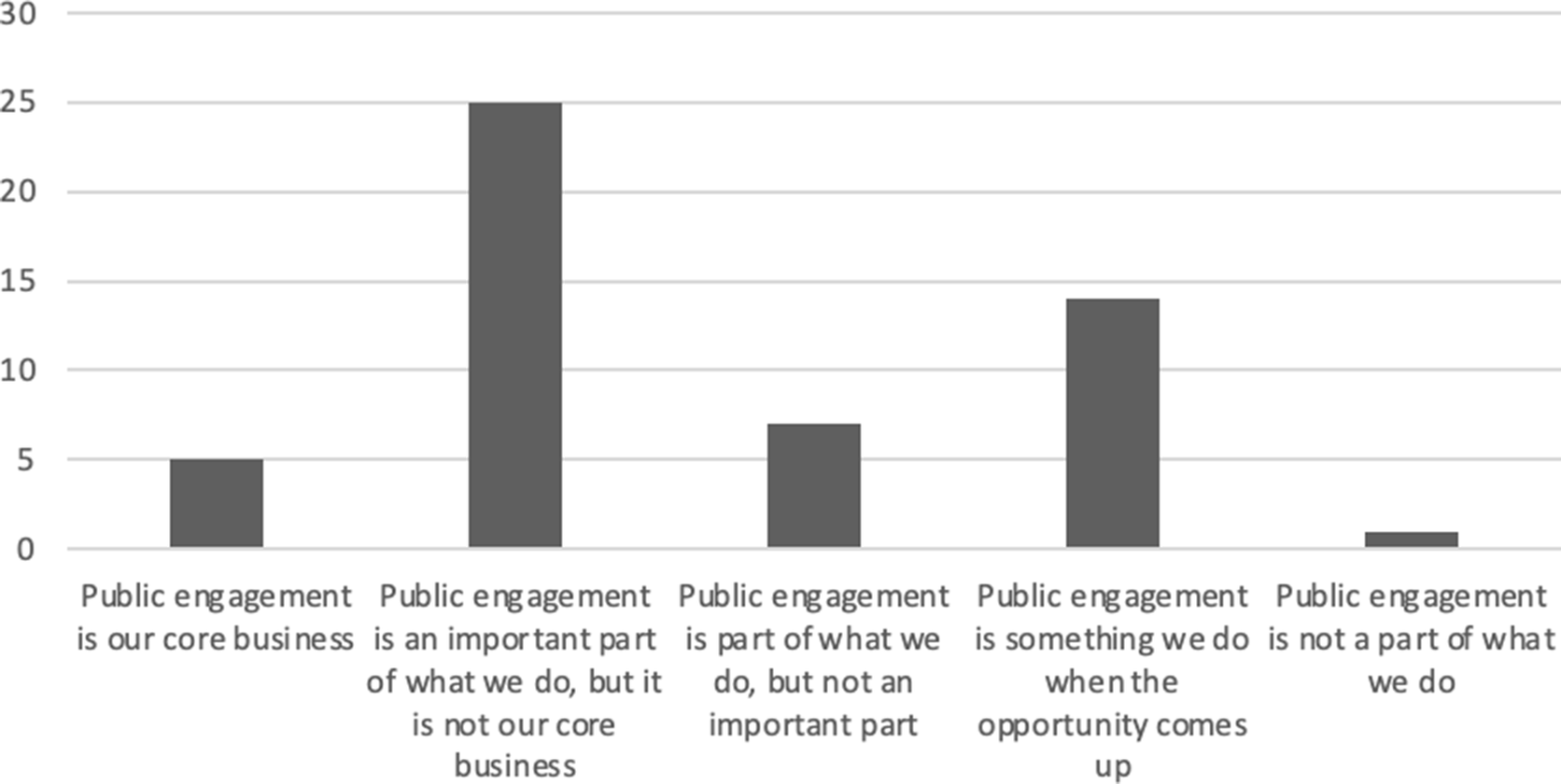
Figure 2. Responses to the question ‘Which of the following best describes you or your organization’s approach to public engagement?’.
What kind of engagement work is the Antarctic sector conducting?
Participants varied in terms of the frequency of their engagement activities (Fig. 3). The highest number (n = 20) reported that they conducted engagement work once a month, with smaller numbers conducting engagement on a daily (n = 11), weekly (n = 11), yearly (n = 10) or less than yearly (n = 3) basis.
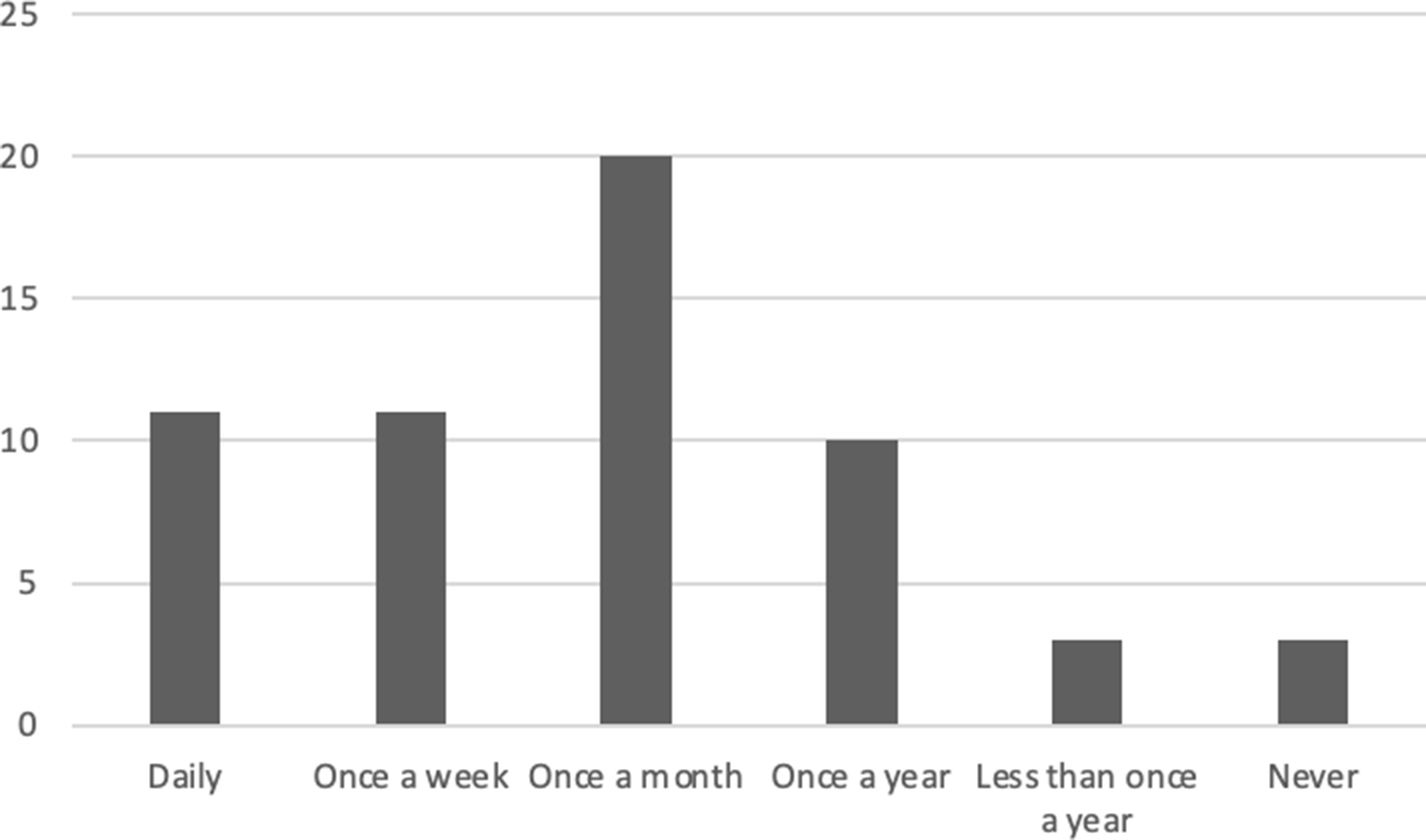
Figure 3. Responses to the question ‘How frequently do you or your organization conduct public engagement activities about Antarctic research?’.
Figure 4 depicts the types of engagement activities participants were involved in. Note that this was a multiple-choice question, with participants being able to select as many options as desired. Overall, activities that focused on communicating research - such as public talks (n = 44), news and media (n = 31) and books and articles (n = 29) - were more common. Less common were activities that were more labour- or resource-intensive, such as open days (n = 14) and festivals (n = 13). Activities that offered members of the public the opportunity to actively participate in Antarctic matters were the least common, including environmental campaigns (n = 9), funding campaigns (n = 6) and volunteering (n = 2).

Figure 4. Responses to the question ‘What types of activities do you deliver?’.
Using open-ended questions, we asked participants about the type of Antarctic research they covered in their engagement activities. Participants described covering a broad range of disciplines from the physical sciences (e.g. glaciology, palaeoclimatology, sea-ice research, oceanography, atmospheric sciences and hydrology), natural sciences (e.g. biology, ecology, environmental sciences, plant physiology and ecosystem dynamics), HASS (e.g. history, heritage, law, geopolitics and governance) and technology (engineering, remote sensing and innovation). One respondent observed that the focus of their engagement activities is ‘Predominantly biophysical sciences - which I think is an issue’; the survey results reflected this predominance.
We also asked participants what research they thought should be prioritized when it came to public engagement. Some participants believed that all research should feature in engagement, with one stating that ‘there should be a balance across all of the science disciplines - all knowledge types have value and should be celebrated’. Others believed that the focus should be on climate change-related research, particularly regarding Southern Hemisphere circulation, effects on weather and climate extremes and changing ice/sea levels. However, it was also noted that ‘Climate science already receives a lot of coverage.’ The global role of Antarctica was another area where it was felt that engagement should be focused, but again this primarily related to climate change effects and impacts. Public engagement activities relating to human activity impacts were also proposed as representing an area for prioritization, particularly relating to tourism and other areas where behaviour change is required: ‘Areas that give the public insight into things they would otherwise have no appreciation of, and areas where their actions have an impact (positive or negative) and/or behavior change is desired.’ Finally, some respondents believed that there should be more of a focus on governance, particularly in terms of the Antarctic Treaty System and policy implementation.
Organizations appeared to rely on a diverse array of funding sources to support their engagement work, including grants and donations (n = 23), fee for service charges (n = 6) and ongoing government funding (n = 12). Seventeen participants reported that their organization included engagement work within its operating budget, and 27 conducted their engagement work unfunded (Fig. 5). Ten participants reported that this funding covered staff hours, seven stated that it did not cover staff hours and a further seven participants reported that this funding sometimes covered staff hours.
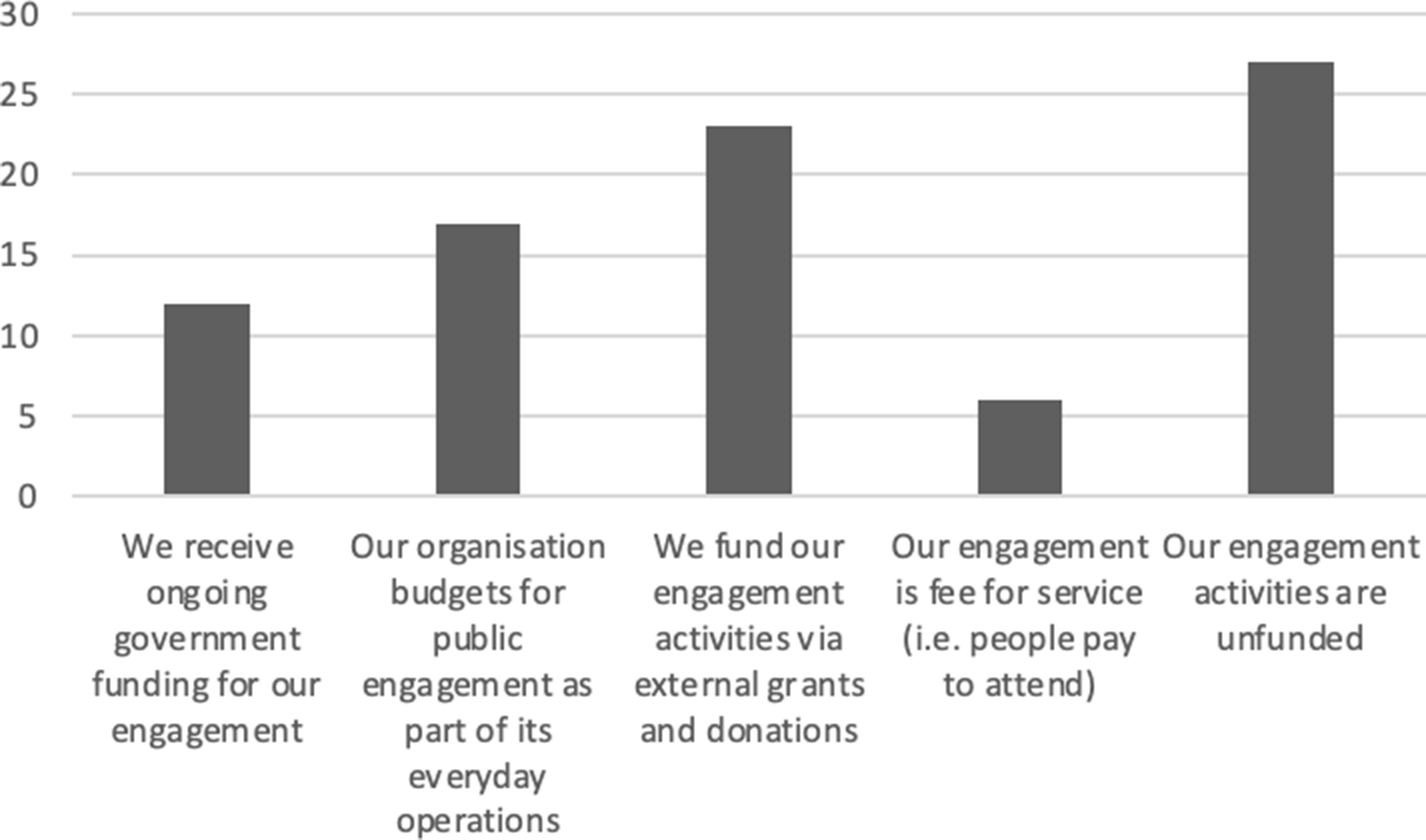
Figure 5. Responses to the question ‘If you deliver engagement activities, how are these funded?’.
From a workforce perspective, participants were split in terms of who had had overall responsibility for their organizations’ public engagement activities (Fig. 6). While 21 participants reported that their organization had specific roles dedicated to engagement, the remaining participants did not report having specific roles, with responsibility for engagement either falling to researchers (n = 18) or to no one in particular (n = 11).
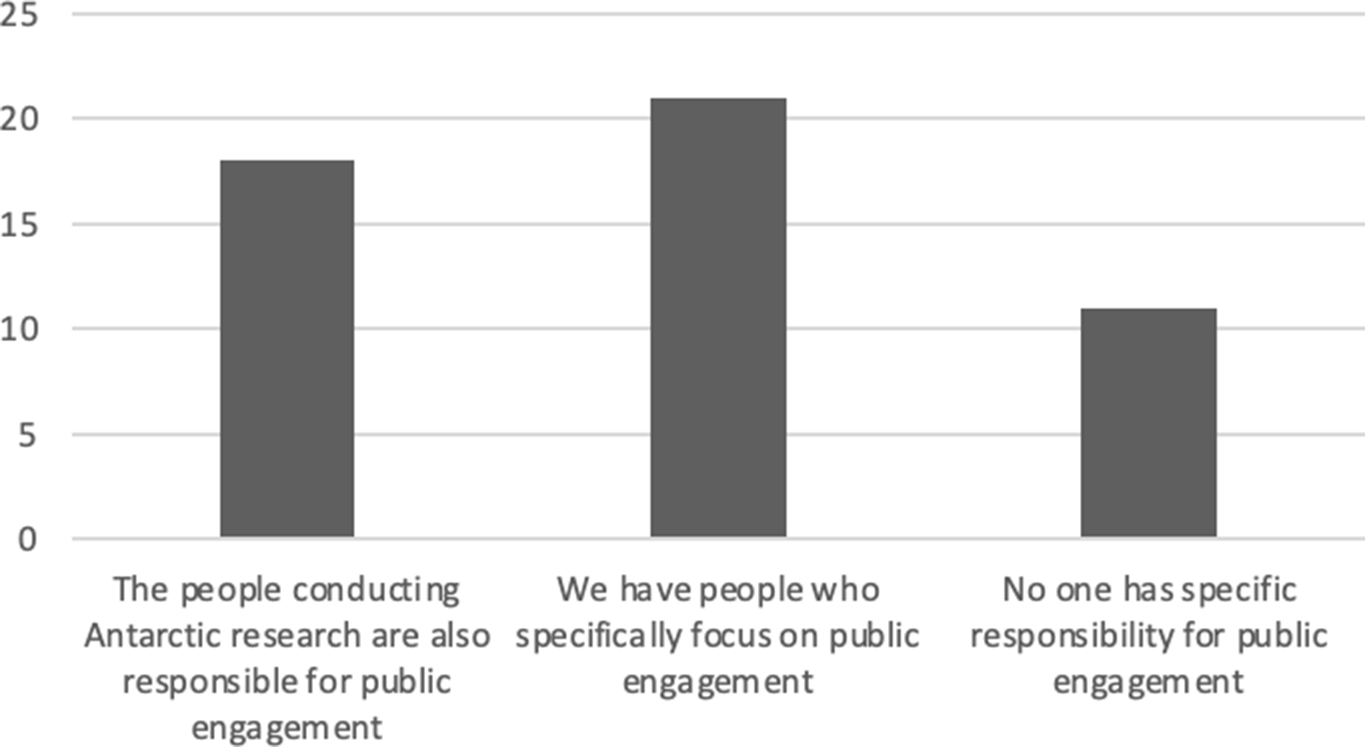
Figure 6. Responses to the question ‘Who is responsible for conducting public engagement work at your organization?’.
What are the barriers to and enablers of conducting engagement work within the Antarctic sector?
Using open-ended questions, we asked participants to describe the barriers and enablers that they had encountered when conducting public engagement work within their own region as well as globally. A number of key themes were apparent within participant responses, as outlined in Table II.
Table II. Summary of open-ended responses regarding barriers to and enablers of Antarctic public engagement.

Participants identified resourcing as the major challenge to engagement work, citing difficulties sourcing time, money and staff hours in a competitive environment. As one participant stated, ‘[T]here is healthy competition for finite resources, so we have to juggle priorities.’ Several participants also highlighted an issue specific to academia, stating that they struggle to justify the time spent on engagement because it did not fit within the narrow performance metrics used to evaluate their output in research and teaching. For those outside of academia, a lack of access to up-to-date information was an issue, with one participant stating that it was difficult to access journal articles that were frequently hidden behind paywalls. To combat resourcing challenges, participants described sourcing funding support from outside agencies, with some attributing their success to funding programmes such as Inspiring Australia, the United Nations Development Programme and National Science Week. In-kind support was also a valuable enabler, with several participants stating that they had benefitted from having access to space and technology to host events, both online and in person.
Beyond resourcing, participants cited a range of other barriers that made it difficult to conduct engagement work. Several participants, for example, described a perceived lack of interest in Antarctica on the part of the media, the education system and the general public. A number of participants also raised some regionally specific barriers to interest, including the perception that Antarctica was geographically far away and therefore less relevant than areas such as the Arctic (Europe) and a general lack of awareness (South Africa). Other participants, by contrast, felt that that there was a high degree of interest in Antarctica, with one simply stating: ‘[P]eople like it.’ The contradiction here indicates a range of understandings of public views of Antarctica that may be influenced by the participants’ different cultural and geographical contexts.
Organizational support played a key role for many participants, with some stating that they felt engagement efforts were stymied by a combination of gatekeeping and a lack of perceived legitimacy. One participant, for example, expressed their frustration with senior staff members, describing ‘older researchers who do not prioritize it [engagement], senior researchers who denigrate outreach staff’. Several participants felt that researchers, and particularly scientists, did not understand or value the skills required to conduct engagement work, with one stating that ‘researchers often don’t value communication experts and think they can do it all but often fail to bring decades of communication research to their work’. Other participants felt that engagement experts themselves lacked expertise:
I think a key barrier is the expertise within the public engagement team itself. They are all ex-journalists and very focused on media engagement e.g., news articles, social media and taking celebrities to the ice. I think there is a lack of expertise in the education space which creates a barrier between our organisation and local schools and the curriculum.
Conversely, several participants indicated that they had benefitted from investing in dedicated roles, including via internship programmes, with one participant commenting: ‘Yes, we had a CEO who was very keen on public engagement/comms. He hired a giant comms team and made it a priority within our organisation. This has not changed since.’ Comments such as these also demonstrated the importance of having motivated people across different organizational levels. While less tangible than resource-related factors, motivation was fundamental to many participants, with some describing the role of enthusiastic volunteers, and one stating: ‘[T]o be honest, I cannot think of anything [that helps with engagement] other than intrinsic motivation to reach out to the wider public.’
Finally, participants also highlighted the importance of having a clear and measurable engagement strategy. One participant noted that ‘it is always helpful to have an elaborate plan’, and another described the benefit of ‘consistent, transparent and timely engagement’ in order to build trust with both the public and the media. Some participants felt that this kind of long-term approach was currently lacking in the Antarctic sector, with one stating that ‘most engagement happens in an ad-hoc organic way without any specific help’. While some participants bemoaned the lack of a strategic approach, one participant described feeling like their organization’s approach was well-articulated but misguided:
Our comms team say that it is not appropriate for them to come across as advocates. This means that they engage with the public on woohoooooo science! rather than providing information about environmental management and threats to Antarctica (which from my perspective is really important).
Noting the importance of strategy to Antarctic public engagement (Salmon & Roop Reference Salmon and Roop2019), we asked participants whether their own organizations had strategies or policies that dealt with public engagement. Thirty-seven participants indicated that their organization had a strategy or policy that related in some way to public engagement, while 25 indicated that their organization did not (Fig. 7). Of the participants who did have an organizational strategy, 20 indicated that this strategy was visible to the public, and a further nine stated that their strategy had been developed through consultation with the public. However, a degree of uncertainty characterized the responses to this question. A number of participants indicated via textual responses that they were unaware of whether their organizations had engagement strategies or how these strategies might have been developed.
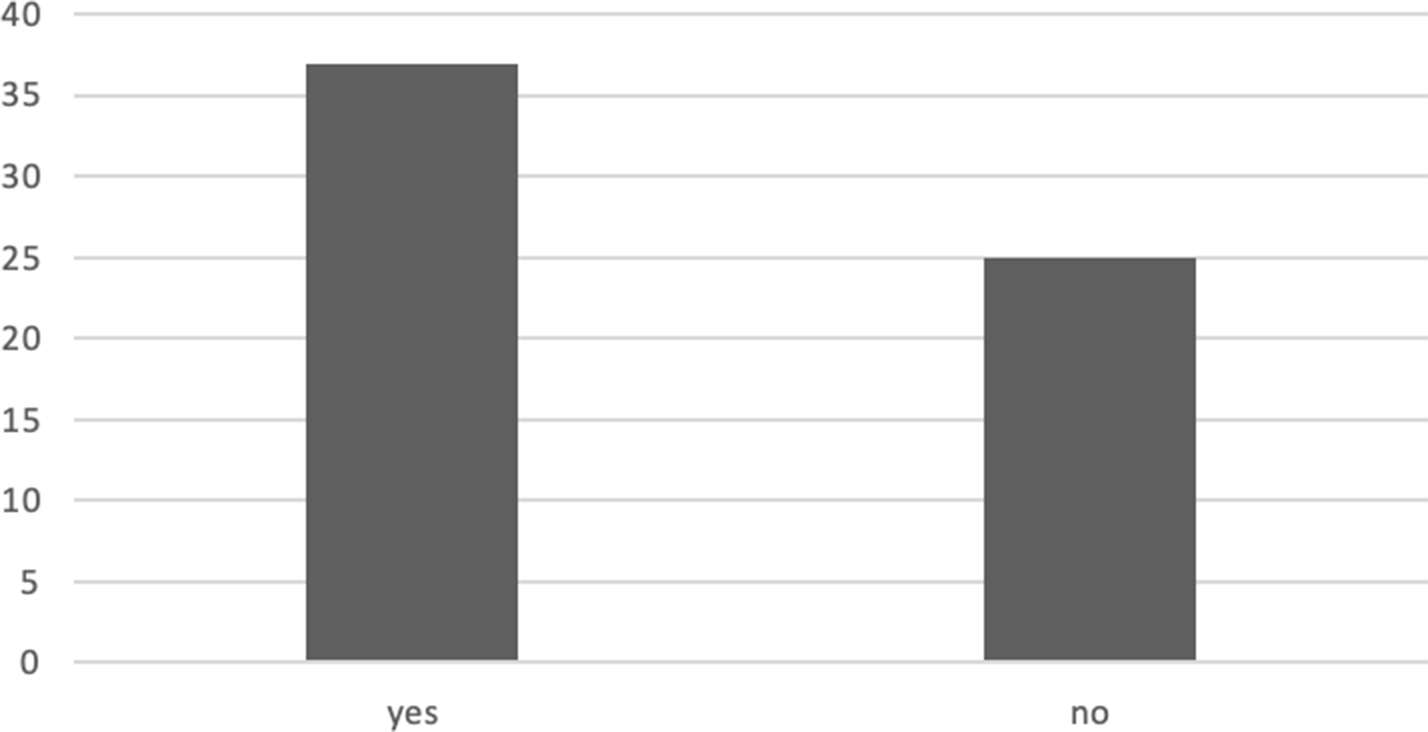
Figure 7. Responses to the question ‘Does your organization have a policy or strategy relating to public engagement? (This does not have to be a policy or strategy specifically dedicated to public engagement. It can be a broader document that references specific plans for engagement)’.
Discussion
We have drawn four key findings from the results presented in this paper:
-
1) The engagement activities conducted by members of the Antarctic sector tend to be ad hoc.
-
2) Engagement activities are mostly focused on informing the public about Antarctica and Antarctic research rather than offering the public opportunities for more in-depth participation.
-
3) Resourcing is a key barrier to public engagement within the Antarctic sector.
-
4) Another key barrier is a lack of legitimacy, reflected in a perceived lack of skill and organizational will.
Some of these findings may reflect the limitations of our survey. For example, the high representation of people from research institutions within our participant sample may account for the preponderance of informing-focused engagement activities. Overall, however, these findings reinforce the results of previous studies conducted within the Antarctic and polar sectors, in particular those reflecting on the fourth IPY (Salmon et al. Reference Salmon, Carlson, Zicus, Pauls, Baeseman and Sparrow2011, Carlson Reference Carlson2019, Salmon & Priestley Reference Salmon and Priestley2019, Salmon & Roop Reference Salmon and Roop2019).
Phenomena such as the recent rapid growth in Antarctic tourism (IAATO 2024a) show that that there is a high level of interest in the southern polar region among some members of the public. Why, then, is the Antarctic sector struggling to create a well-resourced, coordinated and strategic approach to public engagement? A salient comparison is the space sector (e.g. the Mars Exploration Program), where engagement is both effective and driven by long-term strategic plans (Viotti Reference Viotti and Kaminski2021). Given that (as outlined earlier) outer space and Antarctica share many features in common, it is worth considering the differences between these sectors. A key difference is that the majority of space sector engagement tends to be largely driven by NASA and its affiliates (Viotti 2019), which are both well-funded and under the control of one nation-state. Antarctica, by contrast, is currently governed by 58 Treaty signatories, including 29 decision-making Consultative Parties, through a consensus-based system. Numerous national programmes operate in Antarctica, with many having their own internal engagement and education programmes aimed at their citizens. While bodies such as COMNAP’s Education, Outreach and Training group exist to coordinate these efforts, our results suggest that the collaboration described by Salmon et al. (Reference Salmon, Carlson, Zicus, Pauls, Baeseman and Sparrow2011) has fallen away in the years since the 2008–2009 IPY, and that, in its current iteration, the Antarctic sector does not approach the level of cohesion and strategic purpose demonstrated by the space sector when it comes to public engagement.
Our results indicate that many of the problems that researchers observed during and after the fourth IPY still exist and need to be addressed. The fifth IPY, still 7 years away, represents an opportunity to bring coordinating bodies together under a joint engagement strategy informed by evidenced-based research. A joint strategy such as this could also be a step towards a longer-term plan akin to the Mars Exploration Program’s 20 year engagement strategy (Viotti Reference Viotti and Kaminski2021). Antarctica - which is a rapidly changing environment in the warming climate - also needs such long-term thinking at the international level. The Antarctic sector has demonstrated that it has the ability to coordinate large-scale fieldwork-based projects across multiple stakeholders.Footnote 3 As enshrined in the Antarctic Treaty, the sector also places a high value on the sharing of information. Coordinated efforts towards public engagement could be seen as extensions of these strengths and values.
A coordinated engagement strategy may also serve to address the resourcing issues identified in this paper. While individual projects and programmes may struggle to fund substantive engagement efforts, if they considered pooling resources to fund a dedicated engagement team to work across multiple programmes and projects, their efforts could have considerably more impact. Another potential strategy could be to leverage the growth of Antarctic tourism to fund engagement programmes. A potential Antarctic tourism tax has been proposed by scholars (Verbitsky Reference Verbitsky2015) and at the Antarctic Treaty Consultative Meeting (ATCM; Secretariat of the Antarctic Treaty 2024b) to compensate in part for the tourism industry’s environmental impact. One use for the funds derived from this proposed tax could be to support coordinated cross-national engagement efforts, which would in turn support the tourism industry’s goals when it comes to Antarctic ambassadorship (Alexander et al. Reference Alexander, Liggett, Leane, Nielsen, Bailey, Brasier and Haward2020).
Questions of legitimacy are linked to the way in which engagement is often implemented in the Antarctic sector. Our results suggest that an expectation that researchers - largely scientists - will be jacks-of-all-trades, upskilling on engagement if and when opportunities arise and carving time out for engagement efforts from their main task of research. Indeed, as noted by Salmon et al. (Reference Salmon, Priestley and Goven2017), outreach and public engagement activities are generally undertaken by scientists and not by experts in public engagement with science. However, the underpinning assumptions regarding the purpose of these activities, and the role of scientists, are likely to be quite different between these two groups. Public engagement requires a specialist skillset, going beyond public speaking and writing popular pieces into more nuanced and specialized areas such as strategy development and the mapping of public attitudes and knowledge, both of which are research areas in and of themselves. It may be that successful public engagement could also benefit from scientist-communicator reflexivity: considering our own outreach and engagement assumptions as well as the broader context that the engagement is being undertaken within (Salmon et al. Reference Salmon, Priestley and Goven2017). In the Antarctic sector, this could be fostered through collaboration between natural and social scientists when it comes to designing, implementing and studying public engagement efforts. Furthermore, successful public engagement requires an evidence-based and consistent approach to impact measurement, something that is becoming increasingly important to the organizations that fund research (Reed et al. Reference Reed, Ferré, Martin-Ortega, Blanche, Lawford-Rolfe, Dallimer and Holden2021). The legitimization of public engagement work within the Antarctic sector will, therefore, necessarily involve recognizing and valuing engagement as something that is a unique skillset, a distinct research area and a core part of any research programme’s impact agenda.
Conclusion
The 2007–2008 IPY intended one of its legacies to be an ‘exceptional level of interest and participation from polar residents, schoolchildren, the general public, and decision-makers’ (International Science Council 2024). While a range of exciting and important public engagement outcomes were delivered, this study suggests that the lack of a sector-wide engagement strategy and a reduced human and financial capacity for engagement activities may have stymied post-IPY efforts to achieve this goal. If the engagement of diverse communities is to be reprised as a priority for the next IPY, as indeed it should, then the Antarctic sector must invest in this activity. The development of a coordinated strategy that includes an evaluation component, with committed ongoing resources, would address the barriers discussed in this paper and ensure a public engagement legacy that has not yet been experienced in the modern-day Antarctic sector.
Supplementary material
To view supplementary material for this article, please visit https://doi.org/10.1017/S0954102025000070.
Acknowledgements
The authors thank the members of SCAR’s Public Engagement with Antarctic Research action group who provided feedback on survey design at the 2022 online workshop. In addition, we acknowledge the contributions of the people who participated in the survey as well as those who assisted in sharing the survey within their professional networks.
Competing interests
The authors declare none.
Author contributions
Katie Marx led the designing of the survey and contributed to the execution of the survey, interpretation of findings, drafting and revising of the article. Elizabeth Leane led the execution of the survey and contributed to survey design, interpretation of findings, drafting and revising of the article. Karen A. Alexander contributed to survey design, interpretation of findings, drafting and revising of the article.

